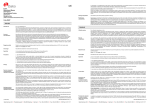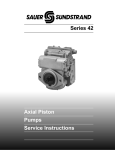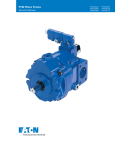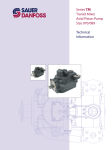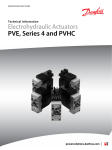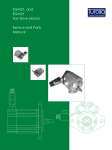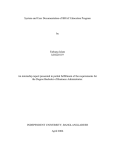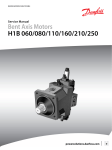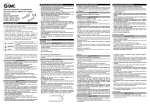Download Series 42 4T Tandem Pumps Service Manual
Transcript
MAKING MODERN LIVING POSSIBLE Service Manual Closed Circuit Axial Piston Pumps Series 42 4T powersolutions.danfoss.com Service Manual Series 42 4T Pumps Revision history Table of revisions 2 Date Changed Rev November 2014 Danfoss layout BA September 2010 New Back Page AC March 2010 Fix Osaka address AB July 2008 First edition AA 11042614 • Rev BA • November 2014 Service Manual Series 42 4T Pumps Contents Introduction General description Technical specifications Pressure measurement Initial Start-Up Procedure Fluid and Filter Maintenance Troubleshooting Adjustments Minor repair Overview..............................................................................................................................................................................................5 Warranty.............................................................................................................................................................................................. 5 General instructions........................................................................................................................................................................ 5 Remove the unit.......................................................................................................................................................................... 5 Keep it clean..................................................................................................................................................................................5 Replace all O-rings and gaskets............................................................................................................................................. 5 Secure the unit............................................................................................................................................................................. 5 Safety precautions............................................................................................................................................................................6 Unintended machine movement..........................................................................................................................................6 Flammable cleaning solvents................................................................................................................................................. 6 Fluid under pressure.................................................................................................................................................................. 6 Personal safety............................................................................................................................................................................. 6 Symbols used in Danfoss literature............................................................................................................................................7 Ordering replacement parts and service................................................................................................................................. 7 Basic design........................................................................................................................................................................................ 8 System diagram................................................................................................................................................................................ 9 System schematic.......................................................................................................................................................................... 10 System specifications................................................................................................................................................................... 11 System parameters........................................................................................................................................................................11 Hydraulic fluid parameters......................................................................................................................................................... 12 Required tools................................................................................................................................................................................. 13 Port locations and pressure gauge installation.................................................................................................................. 13 Ports and pressure gauges......................................................................................................................................................... 13 General...............................................................................................................................................................................................14 Start-up procedure........................................................................................................................................................................ 14 Recommendations........................................................................................................................................................................ 15 Overview........................................................................................................................................................................................... 16 System operating hot...................................................................................................................................................................16 System response is sluggish...................................................................................................................................................... 16 System will not operate in either direction.......................................................................................................................... 17 System will not operate in one direction.............................................................................................................................. 17 Neutral difficult or impossible to find.....................................................................................................................................18 Overview........................................................................................................................................................................................... 19 Displacement limiter adjustment............................................................................................................................................ 19 Conversions................................................................................................................................................................................ 21 Pump neutral adjustment...........................................................................................................................................................21 Control neutral adjustment for MDC and EDC....................................................................................................................22 Standard procedures.................................................................................................................................................................... 24 Remove the pump....................................................................................................................................................................24 Keep it clean............................................................................................................................................................................... 24 Inspect for system contamination......................................................................................................................................24 Replace the O-rings and gaskets.........................................................................................................................................24 Lubricate all moving parts.....................................................................................................................................................24 EDC Spool, linkage, and neutral adjustment screw...........................................................................................................24 Removal........................................................................................................................................................................................24 Installation...................................................................................................................................................................................25 11042614 • Rev BA • November 2014 3 Service Manual Series 42 4T Pumps Contents FNR controls.....................................................................................................................................................................................26 Removal of FNR modules.......................................................................................................................................................27 Installation of FNR modules..................................................................................................................................................27 System Check Relief (SCR) valves)............................................................................................................................................28 Removal........................................................................................................................................................................................28 Inspection....................................................................................................................................................................................29 Replacement.............................................................................................................................................................................. 29 Servo piston covers and NFPH control orifices................................................................................................................... 30 Disassembly................................................................................................................................................................................30 Assembly......................................................................................................................................................................................31 Shafts.................................................................................................................................................................................................. 32 Remove rear shaft.....................................................................................................................................................................33 Remove front shaft (with seal carrier)............................................................................................................................... 33 Remove front shaft (without seal carrier)........................................................................................................................ 33 Inspect shafts............................................................................................................................................................................. 33 Install rear shaft......................................................................................................................................................................... 33 Install front shaft (with seal carrier)....................................................................................................................................33 Install front shaft (without seal carrier).............................................................................................................................33 Port locations and torque chart Fastener, plug and port locations and gauge installation.............................................................................................. 36 Fastener size and torque chart..................................................................................................................................................36 Plug size and torque chart..........................................................................................................................................................36 4 11042614 • Rev BA • November 2014 Service Manual Series 42 4T Pumps Introduction Overview This manual includes information for the installation, maintenance, and minor repair of Series 42 axial piston closed circuit pumps. It includes a description of the unit and its individual components, troubleshooting information, and minor repair procedures. Performing minor repairs requires you remove the unit from the vehicle/machine. Thoroughly clean the unit before beginning maintenance, or repair activities. Since dirt and contamination are the greatest enemies of any type of hydraulic equipment, follow cleanliness requirements strictly. This is especially important when changing the system filter and when removing hoses or plumbing. A worldwide network of Danfoss Global Service Partners (GSPs) is available for major repairs. Danfoss trains and certifies GSPs on a regular basis. You can locate your nearest GSP using the distributor locator at www.sauer-danfoss.com. Click on the Sales and Service link. Warranty Performing installation, maintenance, and minor repairs according to the procedures in this manual does not affect your warranty. Major repairs requiring the removal of a unit’s rear cover or front flange voids the warranty unless done by a Danfoss global service partner. General instructions Follow these general procedures when repairing Series 42 variable displacement closed circuit pumps. Remove the unit Prior to performing minor repairs, remove the unit from the vehicle/machine. Chock the wheels on the vehicle or lock the mechanism to inhibit movement. Be aware that hydraulic fluid may be under high pressure and/or hot. Inspect the outside of the pump and fittings for damage. Cap hoses after removal to prevent contamination. Keep it clean Cleanliness is a primary means of assuring satisfactory pump life, on either new or repaired units. Clean the outside of the pump thoroughly before disassembly. Take care to avoid contamination of the system ports. Cleaning parts with a clean solvent wash and air drying is usually adequate. As with any precision equipment, you must keep all parts free of foreign material and chemicals. Protect all exposed sealing surfaces and open cavities from damage and foreign material. If left unattended, cover the pump with a protective layer of plastic. Replace all O-rings and gaskets Danfoss recommends replacing all O-rings, gaskets, and seals when servicing. Lightly lubricate all O-rings with clean petroleum jelly prior to assembly. Secure the unit 11042614 • Rev BA • November 2014 5 Service Manual Series 42 4T Pumps Introduction For repair, place the unit in a stable position with the shaft pointing downward. It is necessary to secure the pump while removing and torquing end covers, controls, and valves. Safety precautions Always consider safety precautions before beginning a service procedure. Protect yourself and others from injury. Take the following general precautions whenever servicing a hydraulic system. Unintended machine movement W Warning Unintended movement of the machine or mechanism may cause injury to the technician or bystanders. To protect against unintended movement, secure the machine or disable/disconnect the mechanism while servicing. Flammable cleaning solvents W Warning Some cleaning solvents are flammable. To avoid possible fire, do not use cleaning solvents in an area where a source of ignition may be present. Fluid under pressure W Warning Escaping hydraulic fluid under pressure can have sufficient force to penetrate your skin causing serious injury and/or infection. This fluid may also be hot enough to cause burns. Use caution when dealing with hydraulic fluid under pressure. Relieve pressure in the system before removing hoses, fittings, gauges, or components. Never use your hand or any other body part to check for leaks in a pressurized line. Seek medical attention immediately if you are cut by hydraulic fluid. Personal safety W Warning Protect yourself from injury. Use proper safety equipment, including safety glasses, at all times. 6 11042614 • Rev BA • November 2014 Service Manual Series 42 4T Pumps Introduction Symbols used in Danfoss literature WARNING may result in injury Tip, helpful suggestion CAUTION may result in damage to product or property Lubricate with hydraulic fluid Reusable part Apply grease / petroleum jelly Non-reusable part, use a new part Apply locking compound Non-removable item Inspect for wear or damage Option - either part may exist Clean area or part Superseded - parts are not interchangeable Be careful not to scratch or damage Measurement required Note correct orientation Flatness specification Mark orientation for reinstallation Parallelism specification Torque specification External hex head Press in - press fit Internal hex head Pull out with tool – press fit Torx head Cover splines with installation sleeve O-ring boss port Pressure measurement/gauge location or specification The symbols above appear in the illustrations and text of this manual. They are intended to communicate helpful information at the point where it is most useful to the reader. In most instances, the appearance of the symbol itself denotes its meaning. The legend above defines each symbol and explains its purpose. Ordering replacement parts and service Danfoss provides a complete repair service for its products. Contact any Danfoss Global Service Partner for details. To ensure the best performance, use genuine Danfoss replacement parts. To order parts, contact Danfoss Extended Customer Service (ECS) at (515) 239-6078, fax (515) 239-6230, or your nearest Global Service Partner. Some service parts may be available only in kits, while other parts may be available on an individual basis. See publication 520L0589 Series 42 PV 41cc Service Parts Manual or 520L0590 Series 42 PV 28cc Service Parts Manual for listings of available service parts and service kits for Series 42 units. 11042614 • Rev BA • November 2014 7 Service Manual Series 42 4T Pumps General description Basic design S42 Pumps are advanced hydrostatic units for medium power applications with maximum loads of 415 Bar [6020 psi] (41 cm3) and 350 Bar [5075 psi] (51 cm3). You can combine these pumps with a suitable Danfoss motor or other products in a system to transfer and control hydraulic power. The Series 42 variable displacement pump is a compact, high power density unit, using the parallel axial piston/slipper concept in conjunction with a tiltable swashplate to vary the pump’s displacement.. Reversing the angle of the swashplate reverses the flow of fluid from the pump, and reversing the direction of rotation of the motor output. Series 42 pumps provide an infinitely variable speed range between zero and maximum in both forward and reverse. Series 42 pumps use a cradle swashplate design with a hydraulic servo control cylinder. Control is provided through a compact servo control system. A variety of servo controls are available. These include mechanically- or electrically-actuated feedback controls, hydraulic or electric proportional controls, and a three-position electric control. These controls feature low hysteresis and responsive performance. 28/32/41/51 cm3 cross-sectional view Swashplate Slipper Piston Cylinderblock block Cylinder Roller bearing Charge pump Valve plate 8 11042614 • Rev BA • November 2014 Service Manual Series 42 4T Pumps General description System diagram Charge Pressure Control Pressure System Pressure Low Loop Pressure Filter Charge Pump Suction Screen Suction/Case Drain/ System Return Bypass Check Heat Exchanger Reservoir Control Handle Servo Control Cylinder Swash Plate Displacement Control Spool Cylinder Block Assembly Charge Pressure Relief Valve Input Shaft Valiable Displacement Pump Brake release control valve Loop Flushing Valve Gear box Motor Motor displacement control valve Loop Flushing Valve Motor 11042614 • Rev BA • November 2014 P106 147E Charge check/ HPRV valve Gear box 9 Service Manual Series 42 4T Pumps General description System schematic 4T axial piston pump M6 L1 L2 Front Rear M5 M4 M4 M5 M2 Gearbox B M1 A M6 C Motor M1 D M2 Motor Gearbox P107 820E The illustration above shows a schematic of a 4T axial piston pump. System ports A,C and B,D connect to the high pressure work lines. Return fluid is received from its inlet port and discharged through the outlet port. Flow direction is determined by swashplate position. You can read system port pressure through ports M1 and M2. The pump has two case drains (L1 and L2) to ensure there is lubricating fluid in the system. This schematic includes a manual displacement control. For other control schematics see the related control section. 10 11042614 • Rev BA • November 2014 Service Manual Series 42 4T Pumps Technical specifications System specifications General specifications Pump type In-line, axial piston, positive displacement pumps including cradle swashplate and servo control Direction of input rotation Clockwise or counterclockwise Recommended installation position Pump installation recommended with control position on the top or side. Consult Danfoss for non conformance guidelines. The housing must always be filled with hydraulic fluid. Other system requirements Independent braking system, suitable reservoir and heat exchanger. Hardware features Pump configuration Integrated Tandem Pump Displacement cm3/rev [in3/rev] 41 [2.50] x 2 Weight kgf [lbf] MDC: 76 [168] 51 [3.11] x 2 NFPH: 72 [158] Mass moment of inertia kg•m2 [lbf•ft2] 0.0072 [0.0054] 0.0076 [0.0056] Type of front mounting flange (SAE flange size per SAE J744) 2 Bolt SAE C, (4 additional bolt holes available) Port connections SAE-twin ports, radial, opposite side ports System pressure regulation bar [psi] 210-415 [3045-6020] Displacement limiters Option Input shaft options Splined Auxiliary mounting pad (SAE pad per SAE J744) SAE A (9 tooth, 11 tooth, 13 tooth) SAE B (13 tooth) Control options MDC, NFPH, EDC, FNR Loop flushing NONE 210-325 [3045-4715] System parameters Case pressure Continuous pressure bar [psi] 3.4 [50] Maximum pressure (cold start) bar [psi] 10.3 [150] Pressure limits Displacement cm3/rev 41 51 Rated pressure bar [psi] 350 [5075] 325 [4713] Maximum pressure bar [psi] 415 [6017] 350 [5075] Speed limits Displacement cm3/rev 41 Minimum speed min-1 (rpm) 500 Rated speed at maximum displacement min-1 (rpm) 3200 11042614 • Rev BA • November 2014 51 2900 11 Service Manual Series 42 4T Pumps Technical specifications Speed limits (continued) Maximum speed at maximum displacement min-1 (rpm) 3450 3400 41 51 none Charge pump displacement and setting pressure Charge pump Internal cm3/rev [in3/rev] — none Charge relief valve settings bar [psi] Standard 20 [290] Optional 14-24 [203-340] Theoretical flow Displacement cm3/rev 41 51 Theoretical flow at rated speed l/min [US gal/min] 131 [34.6] 148 [39.1] Check / high pressure relief valve Options No relief valve / check only Relief valve / check Settings bar [psi] - 210-415 [3045-6020] or by setting available 210, 250, 280, 300, 325, 345, 360, 385, 415 Hydraulic fluid parameters Fluid temperature range Minimum -40 °C [-40 °F] Intermittent, cold start Maximum continuous 104 °C [220 °F] - Maximum 115 °C [240 °F] Intermittent Fluid cleanliness level Required fluid cleanliness level ISO 4406 Class 22/18/13 Fluid viscosity Minimum 7.0 mm2/s (cSt) Intermittent Recommended operating range 12-60 mm2/s (cSt) - Maximum 1600 mm2/s (cSt) Intermittent, cold start 12 11042614 • Rev BA • November 2014 Series 42 4T Pumps Service Manual Pressure measurement Required tools You can perform the service procedures in this manual using common mechanic’s hand-tools. Calibrate gauges frequently to ensure accuracy. Use snubbers to protect pressure gauges. Port locations and pressure gauge installation On pumps with non-feedback controls, the positions of the case drains may vary. Ports and pressure gauges Proper service and diagnosis may require pressure measurement at various points in the hydraulic circuit. The Series 42 pump has several locations at which to take these measurements. The following illustration shows the locations of the various gauge ports. The table shows the recommended gauge size and the fitting size for each port. Gauge ports Gauge port Pressure measured Recommended gauge size O-ring boss 28 cc 41 / 51 cc M1 & M2 System pressure for ports A and B 600 bar [8700 psi] 9/16/-18 9/16/-18 M4 & M5 Servo pressure 60 bar [870 psi] 9/16-18 9/16-18 L1 & L2 Case pressure 35 bar [510 psi] 1-1/16-12 1-5/16-12 4T gauge ports M4 M2 M5 B system pressure (D on other side) M1 A system pressure (C on other side) L2 (L1 on other side) P107 818E 11042614 • Rev BA • November 2014 13 Service Manual Series 42 4T Pumps Initial Start-Up Procedure General Follow this procedure when starting-up a new Series 42 installation or when restarting an installation in which the pump has been removed. W Warning Unintended movement of the machine or mechanism may cause injury to the technician or bystanders. To protect against unintended movement, secure the machine or disable/disconnect the mechanism while servicing. Prior to installing the pump, inspect for damage incurred during shipping. Make certain all system components (reservoir, hoses, valves, fittings, heat exchanger, etc.) are clean prior to filling with fluid. Start-up procedure 1. Connect the pump to the prime mover. Ensure that pump shaft is properly aligned with the shaft of the prime mover. C Caution Incorrect shaft alignment may result in damage to drive shaft, bearings, or seal which can cause external oil leakage. 2. Fill the reservoir with recommended hydraulic fluid. Always filter fluid through a 10 micron absolute filter pouring into the reservoir. Never reuse hydraulic fluid. 3. Fill the main pump housing with clean hydraulic fluid. Pour filtered oil directly into the upper most case drain port. 4. Fill the inlet line leading from the pump to the reservoir. Check the inlet line for properly tightened fittings and be certain it is free of restrictions and air leaks. 5. To ensure the pump stays filled with oil, install the case drain line in the upper most case drain port. 6. Install a gauge at port M2 to monitor system pressure during start up. Follow recommendations in the vehicle/machine operator’s manual for prime mover start up procedures. 7. While watching the pressure gauge at M2, jog the prime mover or run at the lowest possible speed until system pressure builds to normal levels (minimum 11 bar [160 psi]). Once system pressure is established, increase to full operating speed. If the pump does not maintain system pressure, shut down the prime mover, determine cause, and take corrective action. Refer to Troubleshooting on page 16. 8. Operate the hydraulic system for at least fifteen minutes under light load conditions. 9. Check and adjust control settings as necessary after installation. Refer to Adjustments on page 19. 10. Shut down the prime mover and remove the pressure gauge. Replace plug at port M2. 11. Check the fluid level in the reservoir; add clean filtered fluid if necessary. The pump is now ready for operation. 14 11042614 • Rev BA • November 2014 Service Manual Series 42 4T Pumps Fluid and Filter Maintenance Recommendations To ensure optimum life of Series 42 products, perform regular maintenance of the fluid and filter. Contaminated fluid is the main cause of unit failure. Take care to maintain fluid cleanliness when servicing. Check the reservoir daily for proper fluid level, the presence of water, and rancid fluid odor. Water in the fluid may be noted by a cloudy or milky appearance or free water in the bottom of the reservoir. Rancid odor indicates the fluid has been exposed to excessive heat. Change the fluid immediately if these conditions occur. Correct the problem immediately. Change the fluid and filter per the vehicle/machine manufacturer’s recommendations or at these intervals: Change the fluid more frequently if it becomes contaminated with foreign matter (dirt, water, grease, etc.) or if the fluid is subjected to temperature levels greater that the recommended maximum. Dispose of used hydraulic fluid properly. Never reuse hydraulic fluid. Change filters whenever the fluid is changed or when the filter indicator shows that it is necessary to change the filter. Replace all fluid lost during filter change. Fluid and filter change intervals Sealed reservoir 2000 hours Breather reservoir 500 hours 11042614 • Rev BA • November 2014 15 Service Manual Series 42 4T Pumps Troubleshooting Overview This section provides general steps to follow if you observe certain undesirable system conditions. Some of the items are system specific. Always observe the safety precautions listed in the introduction of this manual. If standard troubleshooting procedures do not remedy the problem, contact a Danfoss Global Service Partner. System operating hot Item Description Action Oil level in reservoir Insufficient hydraulic fluid will not meet the cooling demands of system. Fill the reservoir to the proper level with clean hydraulic oil. Heat exchanger (if equipped) The heat exchanger is not sufficiently cooling the system. Check the air flow and input air temperature for the heat exchanger. Clean, repair, or replace the heat exchanger as necessary. Bypass valve A partially activated bypass valve may result in heat Verify that the bypass valve is fully closed and that generation within the system. the valve is seating properly. Repair or replace it as necessary. SCR (System Check / Relief) Valves A partially activated SCR valve or SCR valves with relief settings too low may result in heat generation within the system. Verify that the SCR valve is seating properly and is at the correct relief setting. Repair or replace it as necessary. Oil filters Clogged oil filters may result in an insufficient supply of cool oil to the system. Inspect the oil filters and verify that they are still operable. Replace them if necessary. Machine load Excessive loads or extreme duty cycles could result in the pump and/ or motor operating at speeds and pressures beyond system design limitations. Verify that the machine is operating within the parameters for which it was designed. If necessary, reduce the load on the machine. Item Description Action Reservoir oil level There is an insufficient amount of hydraulic fluid, resulting in an inadequate supply for the system loop. Fill the reservoir to the proper level with clean hydraulic fluid. Input control signal (linkage, current, or pressure) The pump is receiving a faulty control signal: (MDC Verify that the input signal is correct and identical - binding or broken linkage; EDC - faulty or in both directions. inadequate electrical signal; HDC - blocked or incorrectly orificed control lines). Pump control A damaged pump control or control spool will not correctly transmit the control input signal to the pump. Verify that the pump’s control is operating properly and that the control spool is not damaged or worn and moves freely within its bore. Clean, repair, or replace it as necessary. Bypass valve A partially activated bypass valve will cause cross port leakage. Verify that the bypass valve is closed and that the valve is seating properly. Clean, repair, or replace it as necessary. SCR (system check / relief) valves One or both of the SCR valves may be binding within their bores. Verify that the SCR valves operate freely. Repair or replace them as necessary. Charge pressure (in neutral) Low charge pressure resulting from a damaged charge pump or low charge pressure relief valve setting. Charge pressure may be insufficient to recharge the system loop. Inspect the charge pump for damage and verify the charge pressure relief valve setting. Repair or replace it as necessary. Charge pressure (in stroke) There is low charge pressure resulting from internal Repair or replace the component or components leakage within the system. within the system causing the internal leakage. System response is sluggish 16 11042614 • Rev BA • November 2014 Service Manual Series 42 4T Pumps Troubleshooting Item Description Action Servo pressure There is insufficient pressure differential across the servo piston. Check servo pressures at port M4 and M5 to verify sufficient pressure delta. Verify that the servo supply and drain paths are unobstructed and that any orifices are of the correct size and free of debris. Clean, repair, or replace as necessary. Charge pump The charge pump has been damaged or installed with the incorrect rotational orientation. Verify that the charge pump is in good working order and that it is correctly installed. Repair or replace it as necessary. System will not operate in either direction Item Description Action Oil level in reservoir There is an insufficient amount of hydraulic fluid, resulting in an inadequate supply for the system loop. Fill the reservoir to the proper level with clean hydraulic oil. Input control signal (linkage, current, or pressure) The pump is receiving a faulty control signal: (MDC Verify that the input signal is correct and identical - binding or broken linkage; EDC - faulty or in both directions. Adjust, clean, repair, or replace inadequate electrical signal; HDC - blocked or the input device as necessary. incorrectly orificed control lines). Oil filters Clogged oil filters may result in an insufficient supply of oil to the system. Inspect the oil filters and verify that they are still serviceable. Replace them as necessary. Bypass valve A partially activated bypass valve may result in a cross port leakage. Verify that the bypass valves are closed and that the valves are seating properly. Clean, repair, or replace them as necessary. Charge pressure (in neutral) Charge pressure may be insufficient to recharge the system loop. Inspect the charge pump for damage and verify that the charge pressure relief valve is at the proper setting. Repair or replace it as necessary. Charge pressure (in stroke) Low charge pressure resulting from internal leakage within the system. Repair or replace the component or components within the system causing the internal leakage. Servo pressure There is an insufficient pressure differential across the servo piston. Check servo pressures to verify sufficient pressure delta. Verify that the servo supply and drain paths are unobstructed and that any orifices are of the correct size and free of debris. Clean, repair, or replace them as necessary. Charge pump The charge pump is damaged or has been installed Verify that the charge pump is in good working with the incorrect rotational orientation. order and that it is correctly installed. Repair or replace it as necessary. SCR (system check / relief) valves The SCR valves are malfunctioning or improperly set. Verify that the SCR valves are operating and properly set. Repair or replace them as necessary. Displacement limiters The displacement limiters may be improperly adjusted such that the servo piston is prevented from moving in one direction. Verify that the displacement limiters are adjusted to the proper setting. Item Description Action Input control signal (linkage, current, or pressure) The pump is receiving a faulty control signal: (MDC Verify that the input signal is correct and identical - binding or broken linkage; EDC - faulty or in both directions. Adjust, clean, repair, or replace inadequate electrical signal; HDC - blocked or the control module as necessary. incorrectly orificed control lines). SCR (System Check/Relief) valves The SCR valves are malfunctioning or improperly set. System will not operate in one direction 11042614 • Rev BA • November 2014 Verify that the SCR valves are operating properly. Repair or replace them as necessary. 17 Service Manual Series 42 4T Pumps Troubleshooting Item Description Action Pump control A damaged or biased pump control may be sending a signal commanding the pump to stroke only in one direction. Verify that the pump’s control is functioning properly. Repair or replace it as necessary. Servo pressure The drain or supply path to one side of the servo piston may be blocked. Verify that the servo supply and drain paths are unobstructed and that any orifices are of the correct size and free of debris. Clean or repair them as necessary. Displacement limiters (if equipped) The displacement limiters may be improperly adjusted such that the servo piston is prevented from moving in one direction. Verify that the displacement limiters are adjusted properly. Item Description Action Input control signal (linkage, current, or pressure) The pump is receiving a faulty control signal: (MDC Verify that the input signal is correct and identical - binding or broken linkage; EDC - faulty or in both directions. Adjust, clean, repair, or replace inadequate electrical signal; HDC - blocked or control module as necessary. incorrectly orificed control lines). System pressure With no input signal to the control, a pressure delta Readjust pump neutral setting. Refer to Pump may exist between the two sides of the working neutral adjustment on page 21. loop. Servo pressure With no input signal to the control, a pressure delta Readjust the control neutral setting. Refer to may exist across the servo piston. Control neutral adjustment for MDC and EDC on page 22. PCP pressure (EDCs only) With no input signal to the control, a pressure difference may exist across the control spool. Neutral difficult or impossible to find 18 11042614 • Rev BA • November 2014 Replace the EDC. Service Manual Series 42 4T Pumps Adjustments Overview This section offers instruction on how to perform adjustments to the Series 42 pump. Read through the entire procedure before beginning any service activity. Refer to Port locations and pressure gauge installation on page 13 for location of gauge ports and suggested gauge size. Displacement limiter adjustment You may adjust displacement limiters to achieve a desired maximum flow rate. For Series 42 pumps, displacement limiters are available on one or both sides of the servo piston. Accurate adjustment of the displacement limiters requires the use of a test stand capable of measuring system flow output from both the A and B output ports. 1. Mount the pump onto the test stand. 2. Loosen the displacement limiter seal lock nut (L025), but do not remove it. 3. Start the prime mover and place the pump into full stroke in one direction. Note the system output flow from either the A or B system port. 4. Adjust the displacement limiter adjustment screw (L020) until the desired output flow is reached. Turning the displacement limiter adjustment screw clockwise decreases the maximum output flow setting. Turning the displacement limiter adjustment screw counter clockwise increases the maximum output flow setting. W Warning WARNING The seal nut lock nut must be retorqued after every adjustment and the limiter screw must have full thread engagement in the servo piston cover to prevent unexpected changes in operating conditions and to prevent external leakage during unit operation. The pump achieves maximum flow when the displacement limiter does not contact the servo piston while the unit is in full stroke. One full turn of the displacement limiter adjustment screw results in approximate flow output changes per the table. 5. Once you achieve the proper output flow, torque the displacement limiter seal lock nut (L025) to 20-26 N•m [15-19 lbf•ft] while holding the position of the adjustment screw (L020). 11042614 • Rev BA • November 2014 19 Service Manual Series 42 4T Pumps Adjustments 6. If required, repeat this procedure using the opposite displacement limiter to set the output flow in the other direction. Displacement limiters L020 Displacement limiter 4 mm L025 Displacement limiter seal lock nut 13 mm 20-26 N•m [15-19 lbf•ft] L001 Servo piston cover RIGHT SIDE VIEW (M4) M020 Displacement limiter 4 mm M025 Displacement limiter seal lock nut 13 mm 20-26 N•m [15-19 lbf•ft] M001 Servo piston cover LEFT SIDE VIEW (M5) Displacement limiter adjustment 20 Size Displacement change per turn 41 cm3 5.0 cm3/rev [.31 in3/rev] 11042614 • Rev BA • November 2014 Service Manual Series 42 4T Pumps Adjustments Conversions Changes to the displacement limiter settings are conversions to the pump. Change the nomenclature on the specification tag to reflect the alterations of the unit. Refer to 520L0637 Series 42 Technical Information Manual, Model Code Supplement, or contact your Danfoss representative for the appropriate nomenclature. Pump neutral adjustment Zero output flow from the pump defines the neutral condition. To attain zero output flow, the pump must achieve both mechanical neutral and control neutral conditions. Mechanical neutral is the condition when the swashplate is at zero angle without any signal input from the control. Set mechanical neutral prior to setting control neutral. W Warning To prevent injury, disable the machine: raise wheels off the ground or disconnect the mechanism.. 1. Disable the control input to the pump by equalizing the pressures on both ends of the pump servo piston. To accomplish this, connect an SAE‑06 hose between servo gauge ports, M4 and M5. 2. Install pressure gauges in gauge ports M1 and M2 to measure system pressure. 3. Start the prime mover and run at normal operating speed. 4. Loosen the pump neutral adjustment seal lock nut (T060) in the center of the servo cover on the right side of the pump. 5. Turn the adjustment screw (T015) clockwise until one of the gauges registers an increase in system pressure. Mark the position of the adjustment screw. Turn the screw counterclockwise until the other gauge registers an increase in system pressure. Mark the position of the adjustment screw. Turn the adjustment screw clockwise to a position halfway between the marks. The system pressure gauges should indicate equal pressures. 6. While holding the adjustment screw in position, torque the seal lock nut (T060). Torque to 31-50 N•m [23-37 lbf•ft]. 7. Stop the prime mover and remove the hose between gauge ports M4 and M5. Remove the pressure gauges in gauge ports M1 and M2. Reinstall the plugs in the gauge ports. 8. Proceed to the control neutral adjustment section on the next page. Pump neutral adjustment screw T060 Pump mechanical neutral adjustment seal lock nut See table See table T015 Pump neutral adjustment screw See table See table E100002E MDC Shown 11042614 • Rev BA • November 2014 21 Service Manual Series 42 4T Pumps Adjustments Neutral adjustment gauge port readings M1 / M2 M1 / M2 M1 / M2 P101259 Frame size cm3 41/51 Control MDC/EDC NFP Lock nut mm 17 17 Servo adjust screw mm [in] 7 7 Lock nut torque N•m [lbf•ft ] 31-50 [23-37] 31-50 [23-37] Control neutral adjustment for MDC and EDC Control neutral adjustment aligns the pump swashplate and the control spool so that a zero angle control setting provides a zero degree swashplate setting. Perform this adjustment whenever you adjust or move any part of the control or swashplate mechanism or after you adjust the pump neutral setting. W Warning The following procedure requires the vehicle/machine to be disabled (wheels raised off the ground, work function disconnected, etc.) while performing the procedure in order to prevent injury to the technician and bystanders. 1. Disconnect the external control linkage (for MDC) or control signal input (for EDC) from the pump. 2. Install pressure gauges in the servo gauge ports M4 and M5 to measure pressure on the pump servo piston. 3. Start the prime mover and run at normal operating speed. 4. Loosen the control neutral adjustment seal lock nut (D015). 5. Turn the adjustment screw (D014) clockwise until one of the gauges registers an increase in pressure on the servo piston. Mark the position of the adjustment screw. Turn the screw counterclockwise until the other gauge registers an increase in pressure on the servo piston. Mark the position of the adjustment screw. Turn the adjustment screw clockwise so that it is midway between the marks. Adjustment screw movement produces constant change for both directions, so both the pressure gauges should indicate nearly equal pressures. 6. While holding the adjustment screw (D014) in position, torque the seal lock nut (D015) to 31-50 N•m [23-37 lbf•ft]. 7. Stop the prime mover and remove the pressure gauges. Remove the plugs in the gauge ports. 22 11042614 • Rev BA • November 2014 Service Manual Series 42 4T Pumps Adjustments 8. Connect the external control linkage (for MDC) or control signal input (for EDC) to the pump. Reconnect the work function. Control neutral adjustment screw D014 MDC / EDC neutral adjustment screw 5 mm D015 MDC / EDC neutral adjustment seal lock nut 17 mm 31-50 N•m [23-37 lbf•ft] E100003E EDC Shown Equalization of pressure gauges using pump neutral adjustment screw M3 / M4 M3 / M4 M3 / M4 P101 270E 11042614 • Rev BA • November 2014 23 Service Manual Series 42 4T Pumps Minor repair Standard procedures Remove the pump Prior to performing certain minor repairs on the Series 42 pump, it may be necessary to remove the pump from the machine. Chock wheels of vehicle to prohibit movement. Be aware that hydraulic fluid may be under high pressure and may be hot. Inspect the outside of the pump and fittings for damage. Keep it clean Cleanliness is a primary means of assuring satisfactory pump life, on either new or repaired units. Clean the outside of the pump thoroughly before disassembly. Take care to avoid contamination of the system ports. Clean parts using a clean solvent wash and air dry. As with any precision equipment, keep all parts free of foreign materials and chemicals. Protect all exposed sealing surfaces and open cavities from damage and foreign material. If left unattended, cover the pump with a protective layer of plastic. Inspect for system contamination Inspect the pump for system contamination. If you find contamination, fully disassemble, clean, and inspect all components of the pump. Pump warranty will be voided unless disassembly and rebuild are performed by a Danfoss Global Service Provider. Replace the O-rings and gaskets Danfoss recommends you replace all O-rings and gaskets. Lightly lubricate O-rings with clean petroleum jelly prior to assembly. Lubricate all moving parts During reassembly, coat all moving parts with a film of clean hydraulic oil. This will help to lubricate these parts during start-up. For fluid quality requirements, refer to bulletin 520L0463 Hydraulic Fluids and Lubricants, Technical Information. EDC Spool, linkage, and neutral adjustment screw It may be necessary to remove the control spool, control linkage, and control neutral adjustment screw for cleaning and to change the O-rings or the seal lock nut. Removal 1. Clean the external surface of the pump. 2. Use a T30 Torx to remove the screws (D002). Remove control modules from pump. Remove and discard gaskets (E011). Note control linkage assemblies, and the way the summing links engage the control spool flats. 3. Remove the summing links (D011) by sliding them off the feedback link. Using a 4mm internal hex wrench, remove the summing link pivot pin (D010). Slide the feedback link (D012) towards the servo piston to disengage the neutral adjustment link (D013). Remove all linkages. 4. Remove plugs (D032). Note the orientation of the control spools (D90) and which side of the pump the springs (D91) are located. Remove control spools, washers and springs. 5. Remove the seal nuts (D015) and neutral adjustment screws (D014). Note position of adjustment screws for reassembly. 24 11042614 • Rev BA • November 2014 Service Manual Series 42 4T Pumps Minor repair Installation 1. Install adjustment screws (D014) to position previously noted. Install lock nuts (D015). Do not tighten the nuts. After pump is installed on machine, refer to Control neutral adjustment for MDC and EDC on page 22 for control neutral adjustment procedure. 2. Lubricate and install spools (D90), washers (D92) and springs (D91), noting proper orientation. Install the two side bore plugs and torque to 65 N•m [48 lbf•ft]. 3. Combine the center pin of the feedback links (D012) with the mating bore of the neutral adjustment links (D013). Insert the end of the feedback links into the servo piston slots. Mate the neutral adjustment links with the control neutral adjustment screws (D014). Insert the linkage pivot screws (D010) and torque to 12 N•m [9 lbf•ft]. Install the summing links (D011). It may be necessary to rotate the control spools so that the summing link forks engage the flats on the control spools. 4. Install new gaskets (E011). Install controls. 11042614 • Rev BA • November 2014 25 Service Manual Series 42 4T Pumps Minor repair 5. Install screws (D002). Torque to 16 Nm [12 lbf•ft]. MDC / EDC spool and linkage T30 D002 16 Nm [12 lbf•ft] T30 D002 16 Nm [12 lbf•ft] FD01 RD01 E011 E011 D011 D011 D012 D012 D010 4 mm D013 D010 4 mm D015 17 mm D014 5 mm D032A D032 D091 7/8 inch 65 Nm D092 [48 lbf•ft] D090 D013 F035A F035 6 mm 65 Nm [48 lbf•ft] F035A F035 6 mm 65 Nm [48 lbf•ft] D090 D092 D091 D132A D132 65 Nm 7/8 inch [48 lbf•ft] D015 17 mm D014 5 mm P107 778E FNR controls FNR controls are non-feedback type controls. The FNR controls consist of external, solenoid-actuated spool valves mounted on the pump housing. It may be necessary to remove the FNR controls to clean the ports and replace the O-rings, however the controls themselves are not serviceable. 26 11042614 • Rev BA • November 2014 Service Manual Series 42 4T Pumps Minor repair Removal of FNR modules 1. Clean the pump and control housings. 2. Use a 4 mm internal hex to remove screws (D081). Remove the control modules from the pump housing. 3. Remove and discard the O-rings (FD01A) from the control ports. Examine the ports for cleanliness. 4. Use a 4 mm internal hex to remove screws (D180). Remove plates (D043) and (D143). 5. Remove and discard gaskets (D044). 6. If necessary, remove plugs (D032) and (F035). Remove and discard O-rings (D035A) and (D032A). The spools are solid; other than plugging the bores, they do not provide any function. 7. Unless leaking fluid, adjusting screws (D014) and lock nuts (D015) do not need to be removed. Other than plugging the bores, adjusting screws do not provide any function. Installation of FNR modules 1. If previously removed, install spools (D090). Lubricate and install new O-rings (D032A), and (F035A). Install plugs (D032) and (F035). Torque to 65 Nm [48 lbf•ft]. 2. If previously removed, install adjusting screws (D014) and locknuts (D015). Torque locknuts to 40 Nm [30 lbf•ft]. 3. Clean the sealing surfaces on the controls and housing. 4. Install gaskets (D044). Install plates (D043) and (D143). Use a 4 mm internal hex to install screws (D180). Torque to 16 Nm [12 lbf•ft]. 5. Using petroleum jelly, lubricate and install O-rings (FD01A) to bottom of controls. 11042614 • Rev BA • November 2014 27 Service Manual Series 42 4T Pumps Minor repair 6. Install control modules. Use a 4 mm internal hex, install screws (D081). Torque to 16 N•m [12 lbf•ft]. FNR Minor Repair D081 4 mm 16 N•m [12 lbf•ft] FD01 D081 4 mm 16 N•m [12 lbf•ft] RD01 FD01A FD01A D180 4 mm 16 N•m [12 lbf•ft] D043 D180 4 mm 16 N•m [12 lbf•ft] D043 D044 D044 D014 5 mm 40 N•m [30 lbf•ft] D015 17 mm D090 F035A D032A D032 6 mm 65 N•m [48 lbf•ft] F035 6 mm 65 N•m [48 lbf•ft] F035A F035 6 mm 65 N•m [48 lbf•ft] D032A D032 6 mm 65 N•m [48 lbf•ft] D090 D014 6 mm D015 17 mm 40 N•m [30 lbf•ft] P107 779E System Check Relief (SCR) valves) The System Check Relief valve assembly performs the charge check, high pressure relief, and loop bypass functions. You may remove this assembly for cleaning and replacement of O-rings. Removal 1. Using a 1 inch wrench or an 8 mm internal hex, remove the valve seat plugs (K001) from the pump housing. Remove and discard the O-rings and backup rings (K008, K009, and K010). 28 11042614 • Rev BA • November 2014 Service Manual Series 42 4T Pumps Minor repair 2. Remove the SCR valve assemblies (H005/J005). If SCR valve does not have a bypass plunger, skip steps 3 and 4. 3. Use a snap ring pliers to remove retaining ring (K005). 4. Remove bypass plunger (K002) and O-rings (K006). Discard O-rings. Inspection Inspect the valves and mating seats in the valve seat plugs (K001) for damage or foreign material. The SCR valves (H005/J005) are not serviceable; replace as a complete unit. Replacement If SCR valve does not have a bypass plunger, skip steps 6 and 7. 1. Lubricate and install O-rings (K006) onto bypass plunger. 2. Install bypass plunger (K002). Install snap ring (K005). 3. Install new outer O-ring (K008), backup ring (K009), and inner O-ring (K010) on each valve seat plug. 4. Verify that the conical springs are properly retained on the check poppets/relief valves (H005/J005). Install the check poppet/relief valve assemblies into the pump housing. Ensure that the valve assembly moves freely in its bore. 11042614 • Rev BA • November 2014 29 Service Manual Series 42 4T Pumps Minor repair 5. Using a 1 inch wrench or an 8 mm internal hex, install the valve seat plugs or valve seat/bypass plugs into the pump housing and torque to 82 N•m [60 lbf•ft]. System check relief valve components 82 N•m K001 [60 lbf•ft] 1 inch K005 K002 K006 K008 K009 K008 K010 K009 K010 K001 8 mm 82 N•m [60 lbf•ft] J015 H003 H015 J005 82 N•m [60 lbf•ft] H003 K001 1 inch K005 H005 K010 K009 K008 K001 K006 8 mm K002 82 N•m [60 lbf•ft] K010 K009 K008 P107 780E Servo piston covers and NFPH control orifices You can remove the servo piston covers to replace the gasket or to clean or replace the NFPH control orifices. Disassembly 1. Use a 13 mm or 17 mm wrench to remove locknuts (T060). 30 11042614 • Rev BA • November 2014 Service Manual Series 42 4T Pumps Minor repair 2. Using a T-30 Torx, remove the servo cover screws (L005/M005). W Warning Unintended vehicle movement hazard: When you remove the right side servo piston cover, adjust neutral and control neutral after reinstalling the pump. Refer to Pump neutral adjustment on page 21 and Control neutral adjustment for MDC and EDC on page 22. 3. Remove servo piston covers (L001/M001). To remove the right side servo cover turn the neutral adjusting screws (T015)clockwise until cover can be turned off without interference from housing. 4. Remove gaskets (F009). Clean gasket sealing surfaces. 5. If so equipped, NFPH orifice plugs (E051 and E052) are located beneath the servo covers. If necessary, use a 3 mm internal hex to remove the orifices and clean them. Assembly 1. If previously removed, replace the NFPH orifice plugs (E051, E052). Torque to 2-4 Nm [1.5-3 lbf•ft]. 2. Install new gaskets (L002/M002). 3. On the right side, thread the servo piston cover (L001) onto the neutral adjustment screw. Then, while holding the cover, turn the neutral adjustment screw (T015) counter-clockwise to run the cover down the screw threads. 4. Using a T30 Torx driver, install the servo piston cover screws (L005/M005). Torque to 16 N•m [12 lbf•ft] in the pattern shown. Bolt torque pattern TORQUE BOLTS IN ORDER INDICATED 2 3 4 1 5 Torque this screw first and last P101585 5. Use an 8 mm wrench to secure neutral adjusting screw. Install a new seal lock nut (T060) onto the neutral adjustment screw (T015). Do not torque at this time. 6. Perform pump neutral adjustment and control neutral adjustment procedures. Refer to Control neutral adjustment for MDC and EDC on page 22. Removal of the servo covers may change the position of optional displacement limiters; readjust if necessary (see Displacement limiter adjustment on page 19). Wrench size for locknut (T060) and neutral adjust screw (T015) Frame size cm3 41/51 Control MDC/EDC NFPE/NFPH Lock nut (T060) 17 mm 17 mm Neutral adjust screw (T015) 7 mm 7 mm 11042614 • Rev BA • November 2014 31 Service Manual Series 42 4T Pumps Minor repair Servo piston covers F009 L001 M001 F009 16 Nm [12 lbf•ft] M005 T30 16 Nm [12 lbf•ft] T060 13 mm T30 L005 T060 13 mm L005 T30 16 Nm [12 lbf•ft] L001 T015 Neutral adjust screw F009 F009 16 Nm [12 lbf•ft] T30 M005 P107 781E M001 Removing NFPH orifirces - single pumps shown E051 NFPH orifice 3 mm 2-4 N•m [1.5-3 lbf•ft] E052 NFPH orifice 3 mm 2-4 N•m [1.5-3 lbf•ft] E100026E Shafts Orient housing so shaft to be replaced is on top. Do not move the pump until the shaft has been replace. 32 11042614 • Rev BA • November 2014 Service Manual Series 42 4T Pumps Minor repair Remove rear shaft 1. Remove retaining ring (C012). Remove bearing (C009). 2. Pull shaft (C006) from housing. If necessary, use a snap ring pliers to pull shaft. C Caution Do not damage machined surfaces of pump when removing shaft. Remove front shaft (with seal carrier) 1. Remove retaining ring (F096). Remove shaft seal carrier (C020). 2. Remove shaft seal carrier (C020). Remove and discard O-ring (C017). 3. Press seal out of carrier and discard it. 4. Remove shaft with bearing from housing. 5. If replacing bearing, use a snap-ring pliers to remove retaining ring (C002 or C010). Remove roller bearing (C003 or C008). Remove front shaft (without seal carrier) 1. Remove shaft with bearing from housing. 2. If replacing bearing, use a snap-ring pliers to remove retaining ring ( C010). Remove roller bearing (C008). Inspect shafts Check to see that the shaft and its splines are straight and free of damage or heavy wear. Inspect the shaft sealing surface. Replace the shaft if a groove exists at the sealing land. Clean the sealing area with a nonabrasive material. Install rear shaft 1. Lubricate and install bearing (C009) onto shaft (U001). 2. Install shaft with bearing into housing. C Install retaining ring (C012). Caution Do not damage machined surfaces of pump when removing shaft. Install front shaft (with seal carrier) 1. Lubricate and install bearing (C003) onto shaft. 2. Use a snap ring pliers to install retaining ring (C002). Install shaft with bearing into housing. 3. Lubricate and install seal (C018) into seal carrier (C020). Lubricate and install O-ring (C017). 4. Install seal carrier into housing. Install retaining ring (F096). Install front shaft (without seal carrier) 1. Lubricate and install roller bearing (C008). 11042614 • Rev BA • November 2014 33 Service Manual Series 42 4T Pumps Minor repair 2. Install shaft with bearing into housing. Install retaining ring (C010). Replace shafts Rear shaft Front shafts F096 C012 C020 C010 C009 C017 C008 C018 C002 C003 C006 C005 C001 P107 782E 34 11042614 • Rev BA • November 2014 Service Manual Series 42 4T Pumps Minor repair Seal carrier assembly C017 C018 C020 Seal carrier shown with the inside facing up 11042614 • Rev BA • November 2014 Press seal to bottom of carrier P107 783E 35 Service Manual Series 42 4T Pumps Port locations and torque chart Fastener, plug and port locations and gauge installation The following table shows the fastener, plug and port locations and gauge sizes needed. Port information Port identifier Port size Wrench size Pressure obtained Gauge size, bar [psi] L1, L2 1 5/16-12 UNF-2B 15 mm internal hex Case drain 10 [100] M1, M2 9/16-18 UNF 7 mm internal hex System pressure 600 [10,000] M4, M5 9/16-18 UNF 7 mm internal hex Servo pressure 50 [1000] System ports Port identifier 110 Split flange boss, thread M12 x 1.75 A 1 1/16-12 UN-2B B 1 1/16-12 UN-2B Fastener size and torque chart Item Fastener Wrench size Torque D081 EDC/MDC kit screws (not shown) 1/2 inch 16 N•m [12 lbf•ft] B002 Side cover screws 13 mm 16 N•m [12 lbf•ft] D002 Control cover screws T30 Torx 16 N•m [12 lbf•ft] L020 Displacement limiter adjustment screws 4 mm N/A M005 Servo cover screws T30 Torx 16 N•m [12 lbf•ft] T060 Seal nut 13 mm 23 Nm [17 lbf•ft] Plug size and torque chart Item O-ring plug Wrench size Torque D032 3/4-16 UNF 7/8 inch 65 N•m [48 lbf•ft] D035 3/4-16 UNF 5/16 inch 82 Nm [60 lbf•ft] F093 9/16-18 UNF 1/4 inch 35 N•m [26 lbf•ft] L010 9/16-18 UNF 11/16 inch 35 N•m [26 lbf•ft] K001 3/4-16 UNF 1 inch or 8 mm internal hex 82 Nm [60 lbf•ft] F030 3/4-16 UNF 7/8 inch 65 N•m [48 lbf•ft] F035 3/4-16 UNF 6 mm internal hex 82 Nm [60 lbf•ft] 36 11042614 • Rev BA • November 2014 Service Manual Series 42 4T Pumps Port locations and torque chart Fastener, plug and Port locations L010 M4 F093 M2 D002 F035 M005 K001 F030 D032 L010 M5 T060 L020 L020 T060 B (D on other side) B002 F093 M1 11042614 • Rev BA • November 2014 K001 A (C on other side) L2 (L1 on other side) P107 776E 37 Service Manual Series 42 4T Pumps 38 11042614 • Rev BA • November 2014 Service Manual Series 42 4T Pumps 40 11042614 • Rev BA • November 2014 Products we offer: • • • • • • • • • • • • • • • • Bent Axis Motors Closed Circuit Axial Piston Pumps and Motors Displays Electrohydraulic Power Steering Electrohydraulics Danfoss Power Solutions is a global manufacturer and supplier of high-quality hydraulic and electronic components. We specialize in providing state-of-the-art technology and solutions that excel in the harsh operating conditions of the mobile off-highway market. Building on our extensive applications expertise, we work closely with our customers to ensure exceptional performance for a broad range of off-highway vehicles. We help OEMs around the world speed up system development, reduce costs and bring vehicles to market faster. Danfoss – Your Strongest Partner in Mobile Hydraulics. Hydraulic Power Steering Go to www.powersolutions.danfoss.com for further product information. Integrated Systems Wherever off-highway vehicles are at work, so is Danfoss. We offer expert worldwide support for our customers, ensuring the best possible solutions for outstanding performance. And with an extensive network of Global Service Partners, we also provide comprehensive global service for all of our components. Joysticks and Control Handles Microcontrollers and Software Open Circuit Axial Piston Pumps Orbital Motors Please contact the Danfoss Power Solution representative nearest you. PLUS+1® GUIDE Proportional Valves Sensors Steering Transit Mixer Drives Comatrol www.comatrol.com Schwarzmüller-Inverter www.schwarzmuellerinverter.com Local address: Turolla www.turollaocg.com Valmova www.valmova.com Hydro-Gear www.hydro-gear.com Daikin-Sauer-Danfoss www.daikin-sauer-danfoss.com Danfoss Power Solutions (US) Company 2800 East 13th Street Ames, IA 50010, USA Phone: +1 515 239 6000 Danfoss Power Solutions GmbH & Co. OHG Krokamp 35 D-24539 Neumünster, Germany Phone: +49 4321 871 0 Danfoss Power Solutions ApS Nordborgvej 81 DK-6430 Nordborg, Denmark Phone: +45 7488 2222 Danfoss Power Solutions (Shanghai) Co., Ltd. Building #22, No. 1000 Jin Hai Rd Jin Qiao, Pudong New District Shanghai, China 201206 Phone: +86 21 3418 5200 Danfoss can accept no responsibility for possible errors in catalogues, brochures and other printed material. Danfoss reserves the right to alter its products without notice. This also applies to products already on order provided that such alterations can be made without changes being necessary in specifications already agreed. All trademarks in this material are property of the respective companies. Danfoss and the Danfoss logotype are trademarks of Danfoss A/S. All rights reserved. 11042614 • Rev BA • November 2014 www.danfoss.com © Danfoss A/S, 2013








































